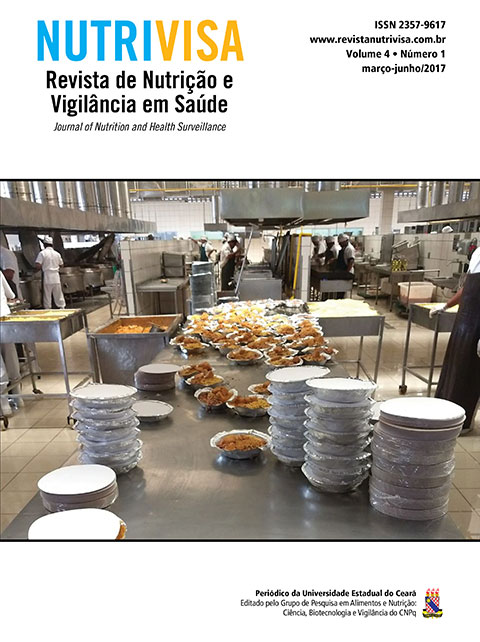Development of quinoa flour based products for the gluten intolerant
DOI:
https://doi.org/10.59171/nutrivisa-2017v4e9014Keywords:
quinoa, celiac disease, glutenAbstract
The objective of this paper was to evaluate the possibility to substitute wheat flour by quinoa flour in the development of recipes for gluten intolerant people. For this, two recipes were taken from cooking sites and adapted by the researchers. For each product a preparation sheet was elaborated, in which TACO – Brazilian Table of Food Composition was used to determine the chemical composition indirectly. Economical viability of the preparations was compared, with possible elaborations containing this protein. There was a significant difference in the proximate values of finished products, in the 60g portion of carrot cake is 3.3 g of protein amount equivalent to 4 %of the VD, the value found in the portion of 30g of chocolate cookies got 3,8 g of protein value of 5% VD, and this is due to the ingredients in addition to the crispy texture, since it was gluten-free. In economic averages of 18.82 ± 9.80 for gluten-free products and 10.66 ± 8.48 for normal products, meaning values are not very discrepant. This food can replace wheat flour and its economic viability is indeed viable since it does not cause discomfort to celiacs.
References
BRASIL. Agência Nacional de Vigilância Sanitária (ANVISA) do Ministério da Saúde. Resolução nº360/2003. Regulamento Técnico sobre Rotulagem Nutricional de Alimentos Embalados, tornando obrigatória a rotulagem nutricional. Diário Oficial da União. 26/12/03.
CASTRO, L. I. A. et al. Quinoa (chenopodium quinoa willd): digestibilidade in vitro desenvolvimento e análise sensorial de preparações destinadas a pacientes celíacos. - Alimentos e Nutrição, Araraquara, v. 18, n. 14, p. 413-419, 2007.
CÉSAR, A. S. et al. Elaboração de pão sem glúten. Revista Ceres, Porto Alegre, v. 56, n. 306, p. 150-155, 2006.
CHUDZIKIEWICZ, F. F. Análise do comportamento de compra e da satisfação do cliente no mercado de panificadoras e confeitarias em Curitiba. Curitiba, 2005. 225 p. Dissertação (Mestrado em Administração)
- Centro de Ciências Sociais Aplicadas, Pontifício Universidade Católica do Paraná: PUCPR, 2005.
GEWEHR, M. F. et al. Análises químicas em flocos de quinoa: Caracterização para utilização em produtos alimentícios. Food Techno, Campinas, v. 15, n. 4, p. 280- 287, out./dez. 2012.
IBGE - Instituto Brasileiro de Geografia e Estatística. Censo Demográfico; 2010.
MORAES, A.C. Federação Nacional das Associações de Celíacos do Brasil: Guia Orientador para Celíacos , Ministério da Justiça, São Paulo p.48, 2010.
NETO,F.B. et al. Qualidade nutricional de cenoura e alface cultivadas em Mossoró-RN em função da densidade populacional, Hortic. bras. v. 24, n. 4, p 476- 480, out.-dez. 2006.
PHILIPPI, S.T; Tabela de composição de Alimentos: Suporte para decisão nutricional, 4 ed. Barueri São Paulo: Manole, 164 p, 2013.
TIRAPEGUI, J. Nutrição, metabolismo e suplementação na atividade física. 2.ed. São Paulo: Atheneu, 350 p , 2005.
YAMANI, B. V.; LANNES, S.C.S. Applications of Quinoa (Chenopodium Quinoa Willd.) and Amaranth (Amaranthus Spp.) and Their Influence in the Nutritional Value of Cereal Based Foods. Food and Public Health, Vol. 2 No. 6, p. 265-275, 2012
ZARDO,F.P.; Análises laboratoriais para o controle de qualidade da farinha de trigo. 2010. 46 p. Monografia
( Graduação em Tecnologia de alimentos) - Instituto Federal de Ciência e Tecnologia do Rio Grande do Sul: IFRS, 2010.
Downloads
Published
How to Cite
Issue
Section
License
Copyright (c) 2017 Charllyton Luis Sena da Costa, Jaderanni Teodoro Batista

This work is licensed under a Creative Commons Attribution 4.0 International License.














